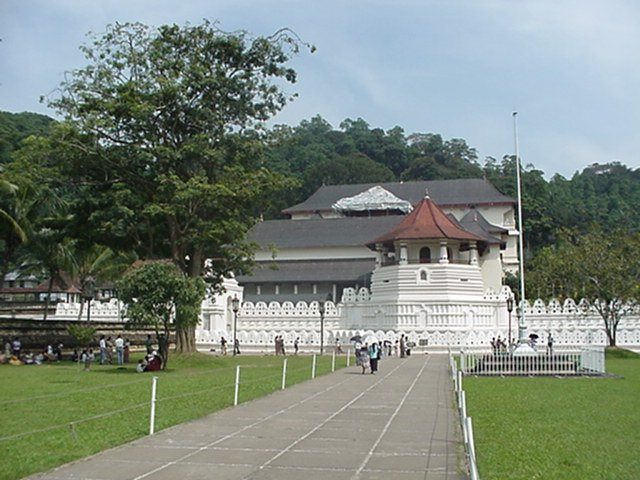

Temple of the Tooth
The Temple of the Tooth in Kandy is undoubtedly Sri Lanka's most famous tourist attraction. Set high in the hills of central Sri Lanka, Kandy was the last stronghold to resist British subjugation. The temple is famous for housing a tooth of the Buddha, extricated from his mortal body before cremation. The tooth itself has an illustrious history, defying pulverization by non-believers, reconstituting itself from dust, and returning magically to its new homeland after abduction--the stuff of legends! It is housed in the temple shown here, and is only taken out and paraded once a year, to great pomp and fanfare. The photo to the left shows the esplanade walkway to the Temple of the Tooth, while the photo to the right is a close-up of the Pattirippuva Octagon tower at the end of the esplanade, from which the king gave audiences.
Entrance to the temple complex
is gained through an elaborately decorated tunnel, a sample of which is
shown at the photo to the left. The tunnel opens unto a small entrance
area where admission fees are paid. From there one enters the
temple proper, through a second tunnel (photo at bottom left) which
leads to the two-storied pillared hall or digge. The area
between the tunnel and the lower level of the inner chamber is termed
the vestibule (Aramudala). This lower vestibule area (shown in the photo at the bottom right) is reserved for
drummers and other traditional forms of music during religious
services. The Aramudala also
contains the
stairway by which daily offering are
taken
to the Sacred Tooth Shrine upstairs. (photo at upper right) The inner
chamber, also pictured in the photo at the bottom right, is similar to
the Buddhist

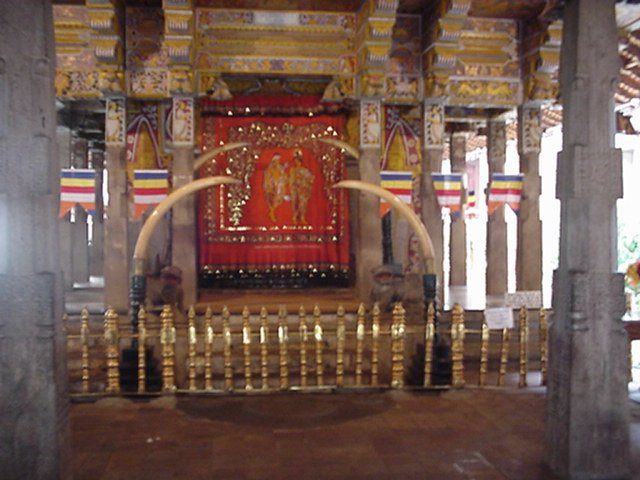
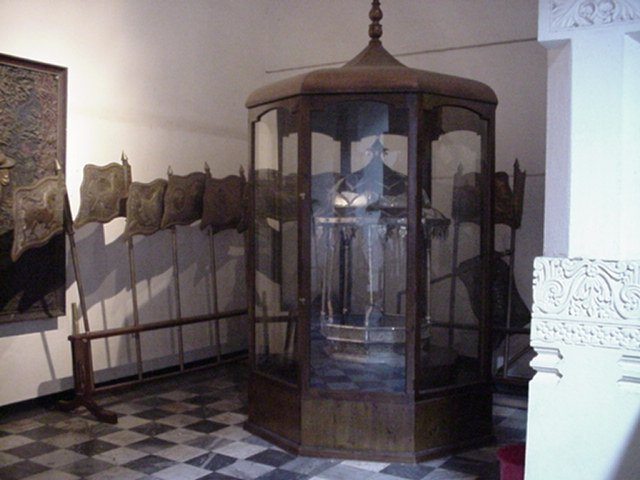
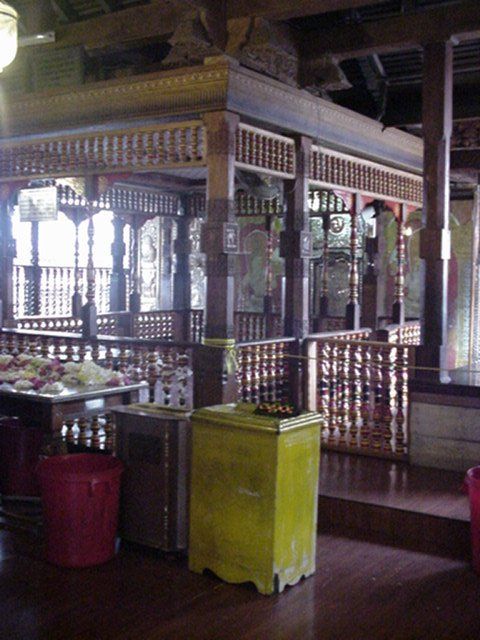

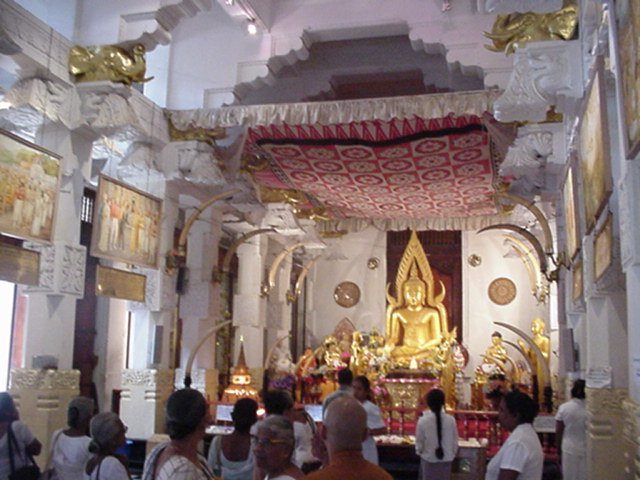
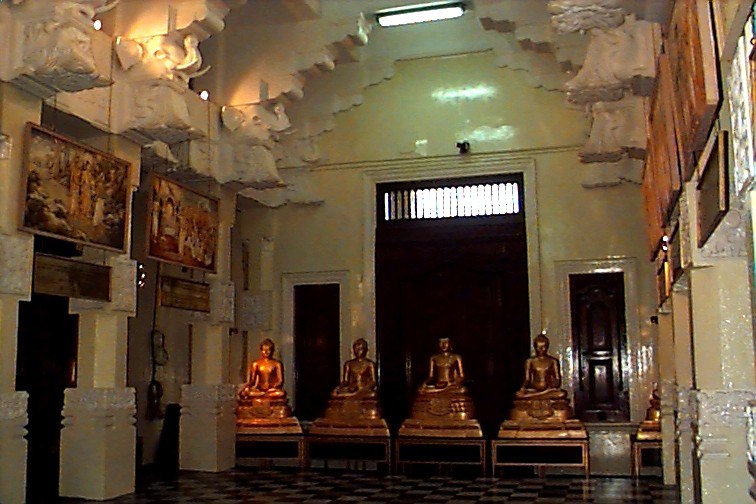 Behind the structure enclosing the two
chambers is
the Alut
Maligava, which houses the New Shrine Room, a very ornate room
built in the Thai style. The central focus of the room is the large
golden Buddha figure at the front of the room. It is surrounded by
gold, ivory, and numerous smaller Buddha statues. (photo to the left).
The rear of the room
contains five Buddhas (photo to the right), while the side walls
likewise contain Buddha figures along with painted panels depicting
scenes from the story of the Tooth Relic (bottom photo). The upper two
stories of this
building have recently been organized into the Sri Dalada Museum, exhibiting donations made to the
Tooth Relic by
devotees and visitors.
Behind the structure enclosing the two
chambers is
the Alut
Maligava, which houses the New Shrine Room, a very ornate room
built in the Thai style. The central focus of the room is the large
golden Buddha figure at the front of the room. It is surrounded by
gold, ivory, and numerous smaller Buddha statues. (photo to the left).
The rear of the room
contains five Buddhas (photo to the right), while the side walls
likewise contain Buddha figures along with painted panels depicting
scenes from the story of the Tooth Relic (bottom photo). The upper two
stories of this
building have recently been organized into the Sri Dalada Museum, exhibiting donations made to the
Tooth Relic by
devotees and visitors.
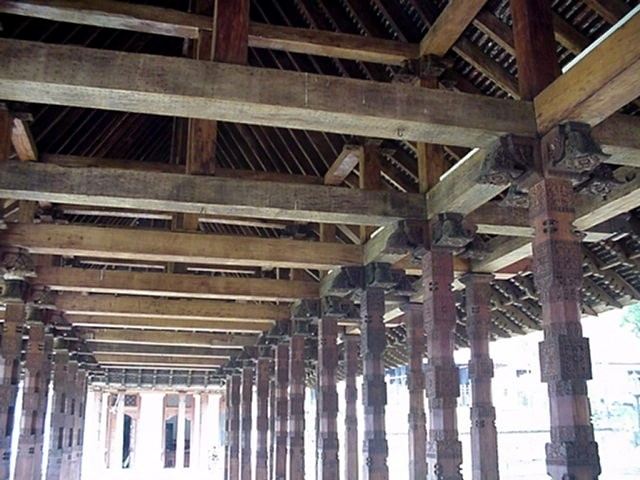
 ]
from the menu at the bottom of the screen. You may view the tour in full-screen mode by clicking on the "full-screen" icon [
]
from the menu at the bottom of the screen. You may view the tour in full-screen mode by clicking on the "full-screen" icon [ ] on the menu at the bottom of the page. If you are using an older
computer and experiencing some "jumpiness" in the panorama, click on
the
compass icon [
] on the menu at the bottom of the page. If you are using an older
computer and experiencing some "jumpiness" in the panorama, click on
the
compass icon [ ]from the bottom menu to smooth things out.
]from the bottom menu to smooth things out.Here is a link to an even more elaborate virtual
tour
of the Temple of the Tooth which, unfortunately, could not be embedded.
It will open in a separate window.